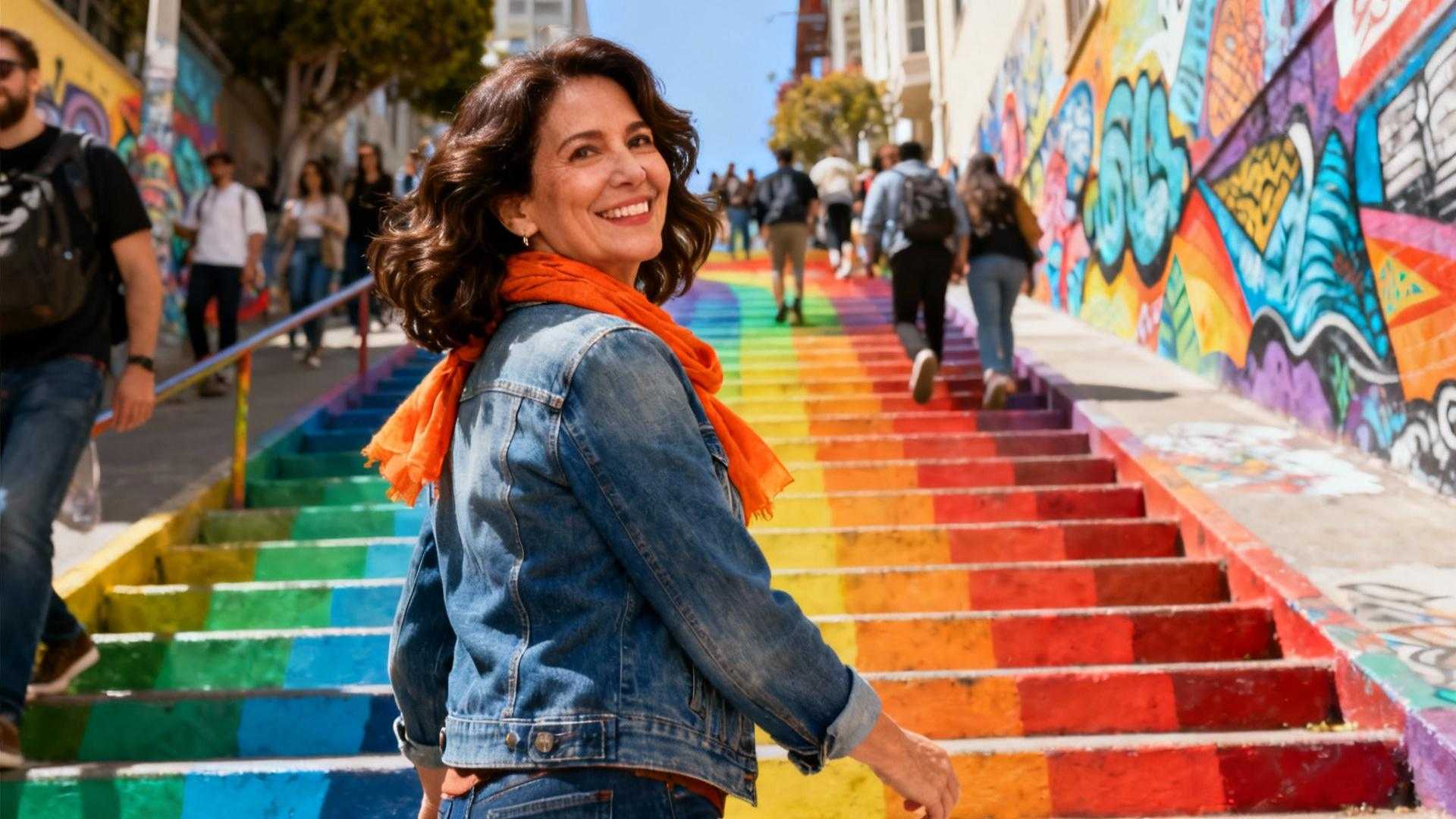I stumbled onto Sanchez Street’s #DoloDrip stairs completely by accident last October. I was searching for the famous 16th Avenue mosaic steps when my phone died two blocks from Dolores Park. Instead of tourist crowds, I found a dripping rainbow mural cascading down 75 steps with absolutely nobody around. By the time I’d systematically tested seven rainbow-colored stairways across San Francisco that weekend, my entire understanding of urban art had transformed.
What started as frustration with a dead phone battery became a methodical exploration challenge. I decided to climb every rainbow and mosaic stairway I could find—comparing artistic merit, crowd levels, neighborhood authenticity, and whether Instagram hype matched reality. Total steps climbed: 847. Total cost: $0. What I discovered changed how I see public art forever.
At 52, I thought museums and galleries held art’s highest expression. Hidden Garden Steps proved me completely wrong.
The dripping rainbow nobody expects
Why #DoloDrip surprised me most
Sanchez Street’s rainbow stairs sit quietly between Sanchez and Noe on 19th Street, just west of Dolores Park. The dripping paint style—created by community artist @dolorainbow in 2022—differs completely from San Francisco’s famous mosaic stairways. I counted maybe four other visitors during my 30-minute visit, despite the #DoloDrip hashtag showing 12,000+ Instagram posts. The mural gets regularly tagged and repainted, creating a living art piece that evolves with neighborhood involvement.
The scale that creates intimacy
At just 75 steps with three small landing benches, this tiny stairway delivers massive impact. October’s golden hour light made the colors practically vibrate. I tested morning versus late afternoon visits—early morning before 9 AM provides softer light that doesn’t wash out the rainbow gradient. The residential location means respectful quiet visits, but also means zero tourist infrastructure disrupting the authentic neighborhood character.
Testing San Francisco’s hidden rainbow network
The famous stairs that disappointed
I found 50+ people crowding 16th Avenue’s Tiled Steps on a Sunday morning. Yes, the 163-step ocean-to-sky mosaic featuring 2,000+ handmade tiles deserves its reputation—the craftsmanship is breathtaking. But the experience felt more like visiting Disneyland than discovering neighborhood art. Similar to Miami’s Wynwood district where hidden murals outshine famous walls, San Francisco’s lesser-known stairways delivered far more authentic connections.
The revelation that changed everything
Hidden Garden Steps in the Inner Sunset broke me open. Just 4-6 visitors even on weekends, 148 intricately tiled steps with native plant landscaping, and a community story embedded in every tile. Three hundred volunteers spent five years creating this between 2010-2013. Standing there alone at sunset, watching neighbors walk by with groceries, I realized this wasn’t a tourist attraction—this was a living neighborhood letting me witness their pride.
What nobody mentions about urban art
The cost advantage museums never discuss
San Francisco’s Museum of Modern Art charges $30 admission for a few hours indoors. I spent an entire weekend exploring seven rainbow stairways—16th Avenue, Hidden Garden Steps, #DoloDrip, Quesada Gardens, Lincoln Park Steps, Lyon Street fitness stairs, and Filbert’s garden stairs—for $0. Add $15 for strategic parking and $30 supporting neighborhood cafés, and I experienced more artistic merit than any museum visit I’ve taken this year.
The fitness bonus nobody calculates
Climbing 847 total steps across three days provided better cardio than my gym routine. San Francisco’s 600+ public stairway network—the highest density of any US city—creates natural urban hiking routes. Just as Medellín’s Metrocable transformed hillside neighborhoods through infrastructure, SF’s community stairway art projects reclaim public space while delivering health benefits tourist overlooks never provide.
The authentic experience mass tourism destroys
Neighborhood courtesy the guidebooks skip
These stairways exist in residential neighborhoods where people live—not designated tourist zones. Keep noise down. Pack out all trash. Don’t block driveways for photos. Support local businesses like Arizmendi Bakery near 16th Avenue or neighborhood cafés near each location. Like Lisbon’s Graça neighborhood where street art transforms hillside communities, respect preserves what makes these places special.
Why October matters for this experience
October provides San Francisco’s best weather—65-75°F with minimal fog and perfect golden hour lighting for photography. Summer’s fog obscures colors; November brings rain. I tested all seven stairways during October’s ideal window. Visit before algorithms discover #DoloDrip, before tour buses find Hidden Garden Steps, before influencers ruin the neighborhoods that created this art.
Common questions about San Francisco’s rainbow stairways
Which stairway should I visit first?
Start with Hidden Garden Steps for the most authentic experience with fewest crowds. It consistently hosts just 4-8 visitors even weekends, offers the most detailed tilework, and provides genuine community connection. Visit early morning for best light and complete solitude.
How do I reach these stairways without a car?
San Francisco’s MUNI system serves all major stairways. The N-Judah line reaches both 16th Avenue and Hidden Garden Steps in the Sunset. The 33-Ashbury and 48-Quintara lines provide alternative access. #DoloDrip sits two blocks from Dolores Park, accessible via multiple routes from Mission District BART stations.
What’s the best time of day for photography?
Early morning (7-9 AM) and late afternoon (4-6 PM) provide optimal October lighting. Morning light stays softer, fewer visitors interrupt compositions, and neighborhood activity remains minimal. Avoid midday harsh sun that washes out rainbow colors, especially at #DoloDrip where direct overhead light flattens the dripping effect.
At 52, Hidden Garden Steps taught me art’s highest purpose isn’t Instagram moments or museum curation—it’s neighbors protecting what makes their place irreplaceable. These stairways represent San Francisco residents transforming infrastructure into cultural statements. Visit before the crowds discover what locals already cherish. Bring respect, leave only footprints, and maybe you’ll understand why 300 volunteers spent five years tiling steps nobody outside their neighborhood knew existed.
